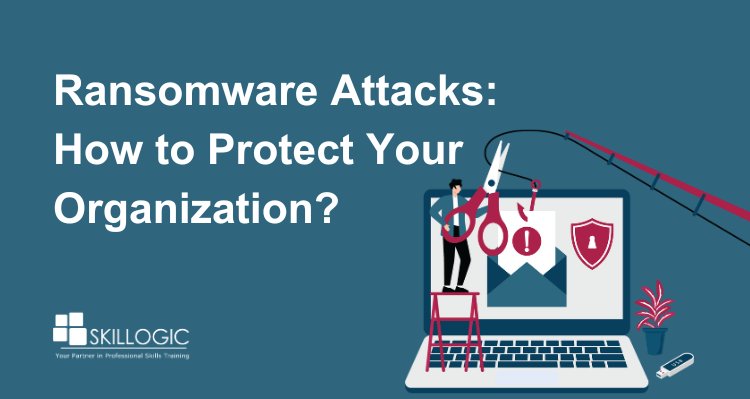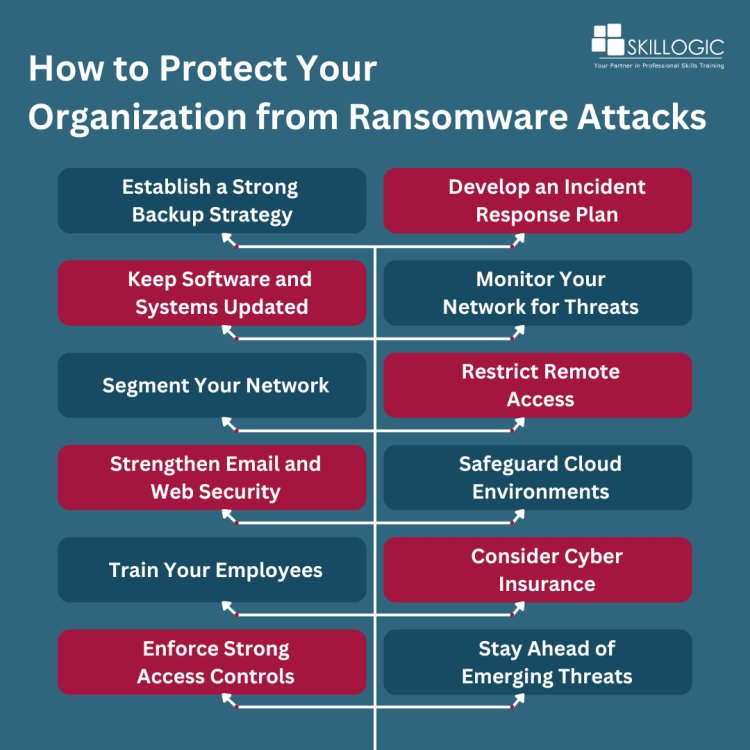Ransomware Attacks: How to Protect Your Organization?

In today's interconnected world, ransomware attacks have emerged as one of the most significant Cyber Security threats facing organizations of all sizes. With the increasing reliance on digital infrastructure, the demand for robust Cyber Security measures has surged. Companies across various sectors, from healthcare to finance, have found themselves in the crosshairs of cybercriminals who exploit vulnerabilities for financial gain.
The scope of ransomware attacks is vast and alarming. According to Cyber Security experts, ransomware incidents have seen exponential growth in recent years, targeting not only large corporations but also small businesses and critical infrastructure. The effects of these attacks can be devastating, ranging from financial losses and operational downtime to severe reputational damage. As organizations grapple with these risks, investing in Cyber Security training and awareness becomes not just an option, but a necessity.
What is Ransomware?
Ransomware is a type of malicious software (malware) that locks or encrypts your files or computer system, making them inaccessible. The attackers then demand a ransom, usually money, in exchange for restoring access to your data. If the ransom isn't paid, the files may remain locked or be lost forever.
There are several types of ransomware, including:
- Crypto Ransomware: Encrypts files and demands payment for decryption.
- Locker Ransomware: Locks users out of their systems entirely.
- Scareware: Tricks users into believing their system has been compromised to extort money.
- Doxware: Intends to disclose sensitive information unless a ransom is paid.
Understanding how ransomware operates is essential for organizations to develop effective prevention strategies.
Refer these articles:
- The Role of Encryption in Cyber Security
- Ethical Hacking vs Cyber Security: What’s the Difference?
- Cyber Security for Small Businesses: How to Stay Safe?
Why is Ransomware a Growing Threat?
The increasing sophistication of ransomware attacks makes them particularly dangerous. Cybercriminals continually refine their techniques, making it easier to bypass traditional security measures. Here are some reasons why ransomware is on the rise:
- Lucrative Financial Gain: The potential for high financial rewards attracts cybercriminals. In many cases, organizations choose to pay the ransom to restore operations quickly, thereby reinforcing this model.
- Widespread Vulnerabilities: Many organizations still rely on outdated systems or lack comprehensive security protocols, making them prime targets for attacks. Vulnerabilities in software and hardware can be exploited easily by attackers.
- Remote Work Environment: The shift to remote work due to the COVID-19 pandemic has increased the number of entry points for ransomware. Employees working from home may inadvertently expose their organizations to threats through insecure networks or devices.
- Increased Use of Ransomware-as-a-Service (RaaS): Cybercriminals now have access to RaaS platforms, which allow even those with limited technical knowledge to launch attacks. This accessibility increases the number of potential attackers in the field.
These factors collectively contribute to the increasing threat of ransomware in the field of cyber security, highlighting the necessity for organizations to remain vigilant and proactive in their defensive strategies. Enrolling in a cyber security course can equip professionals with the skills and knowledge needed to combat these threats effectively.
Refer these articles:
- Cyber Security Course Fee in India
- Cyber Security Scope in India
- How to Become a Cyber Security Expert in India
The Consequences of a Ransomware Attack
The consequences of a ransomware attack can be far-reaching and severe. Organizations that fall victim to these attacks can experience significant operational, financial, and reputational damage.
Operational Disruption
When a ransomware attack occurs, operations are often brought to a standstill. Critical systems may be locked or compromised, preventing employees from accessing essential data. This disruption can lead to delayed services and projects, causing frustration for both employees and customers.
Financial Costs
The financial implications of ransomware attacks can be staggering. In addition to the ransom payment, organizations may face costs related to:
- Business Interruption: Loss of revenue during downtime.
- Recovery Expenses: Costs for forensic investigations, system restorations, and security upgrades.
- Legal Liabilities: Potential fines and legal fees if customer data is compromised.
Moreover, paying the ransom does not guarantee that the data will be restored or that the organization won't be targeted again.
Reputational Damage
The reputational impact of a ransomware attack can be long-lasting. Customers may lose trust in an organization that fails to protect their data, leading to lost business and decreased customer loyalty.
In conclusion, the consequences of ransomware attacks extend beyond immediate financial costs, affecting the overall health and stability of an organization.

How to Protect Your Organization from Ransomware Attacks
Ransomware attacks are becoming more advanced and frequent, making it critical for organizations to adopt a proactive approach to security. Here’s a detailed guide to help safeguard your organization from ransomware threats:
1. Establish a Strong Backup Strategy
- Frequent Backups: Regularly back up critical data and ensure backups are stored offline or on a network isolated from the main system. This prevents ransomware from encrypting both live data and backups.
- Verify Backup Integrity: Test backups routinely to confirm that data can be recovered quickly and accurately when needed.
2. Keep Software and Systems Updated
- Patch Vulnerabilities: Regularly apply updates and patches to your operating systems, software, and firmware. This reduces exposure to vulnerabilities that ransomware can exploit.
- Update Security Tools: Ensure that antivirus and anti-malware solutions, along with other cyber security tools, are up-to-date and provide real-time protection against threats.
3. Segment Your Network
- Separate Critical Systems: Isolate key business systems from less secure areas of your network to limit the spread of ransomware in the event of an attack.
- Control Access: Enforce the principle of least privilege, ensuring users only have access to the systems and data required for their roles.
4. Strengthen Email and Web Security
- Email Filtering: Implement email filtering systems to block suspicious attachments and links, as phishing is a common method for launching ransomware attacks.
- Block Malicious Sites: Use web filtering solutions to prevent access to known malicious websites that may deliver ransomware through infected downloads or ads.
5. Train Your Employees
- Ongoing Security Training: Conduct regular security awareness sessions to educate employees about recognizing phishing attempts, suspicious links, and other warning signs.
- Simulated Attacks: Test employee readiness with phishing simulations to enhance awareness and responsiveness.
6. Enforce Strong Access Controls
- Multi-Factor Authentication (MFA): Use MFA for accessing sensitive systems to add an extra layer of security beyond passwords.
- Encourage Strong Passwords: Promote the use of complex, unique passwords and enforce policies that require regular updates.
7. Develop an Incident Response Plan
- Create a Response Strategy: Develop and document an incident response plan detailing how to respond to ransomware attacks, including isolating compromised systems, contacting authorities, and restoring from backups.
- Assign Key Roles: Define clear roles for your incident response team and conduct regular practice drills to ensure readiness.
8. Monitor Your Network for Threats
- Intrusion Detection Systems (IDS): Implement IDS/IPS solutions to monitor network traffic and detect signs of ransomware or other malicious activities.
- Monitor for Anomalies: Utilize advanced threat detection tools to identify unusual behaviors, such as rapid data encryption, that may signal a ransomware attack and other cyber threats.
9. Restrict Remote Access
- Secure Remote Connections: Use strong encryption for VPNs to secure remote access and limit the use of Remote Desktop Protocol (RDP) to essential users only.
- Strong Authentication: Enforce multi-factor authentication for remote logins and disable unused accounts to reduce attack surface.
10. Safeguard Cloud Environments
- Monitor Cloud Access: Continuously monitor cloud services for unauthorized access or suspicious activity.
- Encrypt Cloud Data: Use encryption for sensitive data stored in the cloud, as well as for data transferred between systems.
11. Consider Cyber Insurance
- Cyber Insurance: Evaluate the benefits of cyber liability insurance to cover financial losses from ransomware, including ransom payments and costs related to data recovery.
12. Stay Ahead of Emerging Threats
- Subscribe to Threat Intelligence: Stay informed by subscribing to security reports and feeds that track the latest ransomware tactics and variants.
- Collaborate with Peers: Join industry-specific security communities to share insights and stay updated on new attack methods and defense strategies.
By adopting these layered security practices, your organization can significantly mitigate both the likelihood and impact of ransomware attacks. In the evolving future of cyber security, vigilance, education, and a robust security posture will be essential to staying protected against today’s threats.
Refer these articles:
- Cyber security Scope in Chennai
- Cyber Security Expert in Hyderabad
- Cyber Security Course Fees in Bangalore
10 Best Ransomware Prevention Practices
To safeguard against ransomware, organizations should adopt best practices that form a robust defense strategy. Below are ten effective prevention practices:
1. Regular Software Updates:
- Keep all software and operating systems up to date to close security gaps.
- Enable automatic updates wherever possible.
2. Implement Network Segmentation:
- Divide the network into segments to limit the spread of ransomware.
- Control access to critical systems and data.
3. Utilize Email Filtering:
- Implement email filtering solutions to prevent malicious attachments and links.
- Train employees to recognize suspicious emails.
4. Enforce Strong Password Policies:
- Require complex passwords and regular changes.
- Educate employees about password management tools.
5. Monitor Network Traffic:
- Use security information and event management (SIEM) tools to monitor network activity.
- Identify any atypical patterns that could suggest an attack.
6. Test Incident Response Plans:
- Develop and regularly test incident response plans to ensure quick action during an attack.
- Include scenarios involving ransomware attacks.
7. Limit Remote Access:
- Restrict remote access to sensitive systems.
- Use virtual private networks (VPNs) to ensure secure connections.
8. Conduct Employee Training Programs:
- Provide ongoing Cyber Security training for all employees.
- Include phishing simulation exercises to enhance awareness.
9. Maintain an Incident Response Team:
- Establish a dedicated team to manage and respond to Cyber Security incidents.
- Ensure team members are trained and ready to act.
10. Invest in Cyber Security Courses:
- Enroll employees in a Top Cyber Security training to enhance their knowledge and skills.
- Encourage participation in Cyber Security training programs to stay current on threats.
By implementing these best practices, organizations can create a multi-layered defense against ransomware attacks.
Ransomware attacks pose a serious threat to organizations worldwide. By understanding the nature of these attacks and implementing effective Cyber Security measures, organizations can greatly reduce risks and safeguard their valuable data. Investing in Cyber Security training programs is crucial for building a strong defense and staying resilient against evolving cyber threats.
At SKILLOGIC Institute, we recognize the growing significance of Cyber Security in the modern digital environment. Our Cyber Security Professional Plus Course is designed to equip learners with the skills needed to address security challenges across various industries. This program is accredited by top organizations like IIFIS and NASSCOM FutureSkills, offering extensive training that includes hands-on projects and specialized practice labs.This hands-on approach ensures that participants not only gain practical experience but also acquire a deep understanding of how to protect systems from potential threats.
With more than 100,000 empowered learners, SKILLOGIC is dedicated to enhancing careers in Cyber Security by providing top-notch education and practical experience.Our focus on real-world applications and industry-recognized certifications makes us the ideal choice for professionals aiming to excel in the dynamic field of Cyber Security. Join us to enhance your skills and play a key role in safeguarding the future of technology.

0
150